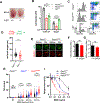Inactive Parp2 causes Tp53-dependent lethal anemia by blocking replication-associated nick ligation in erythroblasts
- PMID: 39383878
- PMCID: PMC11615737
- DOI: 10.1016/j.molcel.2024.09.020
Inactive Parp2 causes Tp53-dependent lethal anemia by blocking replication-associated nick ligation in erythroblasts
Abstract
Poly (ADP-ribose) polymerase (PARP) 1 and 2 enzymatic inhibitors (PARPi) are promising cancer treatments. But recently, their use has been hindered by unexplained severe anemia and treatment-related leukemia. In addition to enzymatic inhibition, PARPi also trap PARP1 and 2 at DNA lesions. Here we report that, unlike Parp2-/- mice, which develop normally, mice expressing catalytically inactive Parp2 (E534A and Parp2EA/EA) succumb to Tp53- and Chk2-dependent erythropoietic failure in utero, mirroring Lig1-/- mice. While DNA damage mainly activates PARP1, we demonstrate that DNA replication activates PARP2 robustly. PARP2 is selectively recruited and activated by 5'-phosphorylated nicks (5'p-nicks), including those between Okazaki fragments, resolved by ligase 1 (Lig1) and Lig3. Inactive PARP2, but not its active form or absence, impedes Lig1- and Lig3-mediated ligation, causing dose-dependent replication fork collapse, which is detrimental to erythroblasts with ultra-fast forks. This PARylation-dependent structural function of PARP2 at 5'p-nicks explains the detrimental effects of PARP2 inactivation on erythropoiesis, shedding light on PARPi-induced anemia and the selection for TP53/CHK2 loss.
Keywords: 5′p-nicks; Lig1; PARP inhibition; PARP inhibitor; PARP2; anemia; erythropoiesis; hematological toxicity.
Copyright © 2024 Elsevier Inc. All rights reserved.
Conflict of interest statement
Declaration of interests D.M. is a scientific editor for Molecular Cell and therefore was not involved in the peer review or the decision-making process of this manuscript.
Figures







Update of
-
Inactive Parp2 causes Tp53-dependent lethal anemia by blocking replication-associated nick ligation in erythroblasts.bioRxiv [Preprint]. 2024 Mar 14:2024.03.12.584665. doi: 10.1101/2024.03.12.584665. bioRxiv. 2024. Update in: Mol Cell. 2024 Oct 17;84(20):3916-3931.e7. doi: 10.1016/j.molcel.2024.09.020. PMID: 38559022 Free PMC article. Updated. Preprint.
References
MeSH terms
Substances
Grants and funding
- R56 NS037956/NS/NINDS NIH HHS/United States
- R01 NS037956/NS/NINDS NIH HHS/United States
- R01 CA271595/CA/NCI NIH HHS/United States
- P01 CA174653/CA/NCI NIH HHS/United States
- P30 CA021765/CA/NCI NIH HHS/United States
- R01 NS123081/NS/NINDS NIH HHS/United States
- R01 CA158073/CA/NCI NIH HHS/United States
- R01 CA184187/CA/NCI NIH HHS/United States
- R01 CA275184/CA/NCI NIH HHS/United States
- R01 CA226852/CA/NCI NIH HHS/United States
- R01 GM057479/GM/NIGMS NIH HHS/United States
- P30 CA013696/CA/NCI NIH HHS/United States
- R01 CA276837/CA/NCI NIH HHS/United States
- P01 CA247773/CA/NCI NIH HHS/United States
- R01 CA293675/CA/NCI NIH HHS/United States
LinkOut - more resources
Full Text Sources
Medical
Molecular Biology Databases
Research Materials
Miscellaneous

